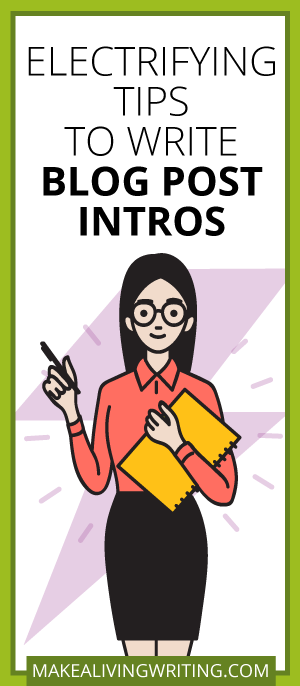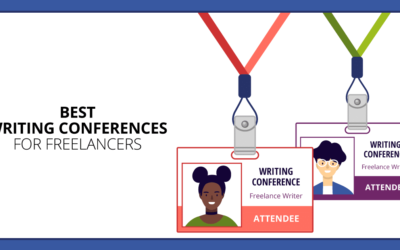
You’ve probably already heard the usual tips…Open a blog post with a question, statistic, or quotation. Wait until you’ve drafted the post body before writing the intro. Start in the middle of the action.
But that doesn’t help you to get the actual words out and get your blog post introduction DONE — let alone done RIGHT.
It’s OK. Let the tension out of your shoulders, unclench your jaw, and take a moment to clear your mind. (A short moment. I’m still right here, and we have work to do on your blog post intros!)
Now it’s time to shock your system with some major volts of creativity to write blog post intros that fascinate readers.
By the end of this post, you’ll be ready to write an electrifying intro for your next blog post. I’ll even give you a straightforward step-by-step template to follow.
Why your blog post introductions matter
As a rule, bloggers don’t assign values to different parts of a blog post like:
- “So this title is worth $100.”
- “The blog post introduction is worth another $100.”
- “The rest of the post is worth $100 as well.”
But if they could…the value share between these 3 elements of a blog post would be pretty even, just like in the example above.
Yep, that means that if you’re a freelance blogger working on a $500 blog post, your blog post introduction is worth approximately $167. Wow! (nO pReSSuRe…)
Blog post intros are valuable
Why? Because if somebody sees a blog post title and finds it compelling enough to click, the first thing they’ll see — after the title, which they already read — is the introduction.
So if that doesn’t draw them in and keep them reading, or at least convince them to scan the rest of the post, then they won’t go any further.
The other thing that makes how you open a blog post matter is that search engines like Google and Bing pay a lot of attention to what you say in the first 150 to 200-ish words of your posts. The better you craft that opening, the more readers you get from organic search engine results!
Time for a quick recap before we move on
- Your blog post introduction is worth roughly one-third of the value of your entire post.
- It has to draw your reader in so that they read the rest of your post.
- Search engines analyze details of your blog post openings to decide how high on search results pages they should rank your post.
Let’s consider human readers before search engines.
How to write a blog post intro that fascinates readers
Follow these four electrifying rules to create a blog post lead that lights up your audience:
1. Talk to your reader
If you haven’t used the words “you”, “your”, or “yours” in the first sentence you write, then you might want to adjust your focus so that it’s firmly on the reader and you’re talking directly to them.
2. Make sure they know that you get it
OK, now you’re talking to your reader, the first thing to say is what’s hurting them.
Whatever the topic of your post is, people will read it because they either want help to get rid of a pain in their lives, or help to get something they really want (so much that going without it is a pain).
Your target reader can’t tell if this post is really for them until you show them you see their situation. So say it clearly and plainly.
3. Get ’em right in the feels
Just knowing the situation isn’t enough. Your reader needs to feel understood on a deeper level to commit to reading what you write.
How can you do that when you’ve never met the reader, and when you have thousands of readers to reach? It isn’t as hard as it sounds.
Try to see things from the perspective of your target reader. Imagine the thoughts and emotions they have about the topic you’re covering. Now bring that empathy into your intro.
Don’t just name emotions, describe how they feel. Compare these 2 ways you could say the same thing:
- “Every time this happens, you get frustrated.”
- “Every time this happens, your stomach churns and you grit your teeth in frustration.”
See what I mean? You’re aiming for something more like the second one than the first. (Although the first one is still a lot better than zero empathy.)
4. Promise to fix the pain with a plan
Literally just writing “I promise I will help you” isn’t gonna cut it. Your reader needs a sense that you actually have a way to make it happen!
You can often get this part nailed just by pointing out the underlying cause of the reader’s pain and then outlining how a solution to that problem could work.
For example: “Your struggle with handwriting doesn’t come from poor education or laziness. It’s your pen that’s the real problem, because it doesn’t fit your hand well enough. So let’s talk about getting you the right pen.”
A hint is all you need to give here — the rest of your post will deliver the details.
Craft blog post intros that search engines love
Some bloggers are good with search engine optimization (SEO), some hate it with a passion, some are barely aware of it.
If you’re an #SEOhater, look at it this way:
SEO is how search engines figure out if what you’ve written is what an individual searcher is looking for.
So it’s part of your service to your readers — and clients — to make sure Google knows which searchers to send your way!
If you don’t spend any time on SEO at all…
You might be lucky enough to find that you happen to have done it by accident. Because writing about a topic generally means you’ll use the commonly used words to describe it, and those are the same words people will use when searching.
But if you purposely choose to ignore all the SEO…
You run the risk of leaving behind a proportion of searchers who were desperate for a blog post like yours. And all because you decided SEO wasn’t worth your while. Shame, shame, shame.
More important, if you want to write blog posts for clients or get good guest post spots, doing at least basic SEO on your blog post opening is part of the gig.
Make a Living Writing editor Evan Jensen told me that MALW staff devote plenty of time to polishing the first 175 words of every post to help it rank better on search results pages. Other popular sites do the same, so if you want editors to love you, you’ll stay up to date with SEO fundamentals.
What to do with SEO keywords
When you’re writing for clients, they’ll usually give you a keyword to target for SEO. Or it may be one primary keyword and a set of secondary keywords.
If you need to choose keywords yourself, for example on your own blog, you can use a free keyword research tool to help — just Google “free keyword research tools for bloggers” to get a list of tools to try out.
- Your primary keyword should be used in the blog post title (not technically part of the intro, but worth mentioning because using your keyword in the opening without having it in the title would be a silly mistake to make)
Then you want to make sure you use your primary SEO keyword *at least* once in the first few lines of the post. And using a couple of secondary keywords in the first couple hundred words is good practice too.
If there’s a heading within the blog post opening or immediately after it, that heading should also include your primary keyword.
Simple enough, right?
Now we combine the reader-centric approach with the SEO tactics to give you… *drumroll*… Sophie’s blog post introduction template! (Not just mine anymore. Yours now, too.)
Your 3-step blog post introduction template
- First couple of lines: Talk to the reader and include your primary keyword.
- In the middle: Say what the reader’s pain is and how it feels. Include your primary keyword and a few secondary keywords. [Optional/contextual: Also explain the underlying cause of the pain.]
- At the end of the intro: Transition to the post body by saying what kind of solution you’ll write about in the rest of the post. Include primary or secondary keywords, and use the primary keyword in your first section heading too.
That’s it. That’s all there is to it.
Now that you’ve got these tips and steps to walk you through the process, including what to do about SEO in blog post introductions, you’re all set to craft a killer opening to your next post.
How do you tackle blog post intros? Let’s discuss in the comments.
Sophie Lizard is a freelance blogging coach with more than a decade of experience writing blog posts for pay. She started out at $50 per post back in 2008 and now earns an average of $1000 for a typical blog post in 2020.










